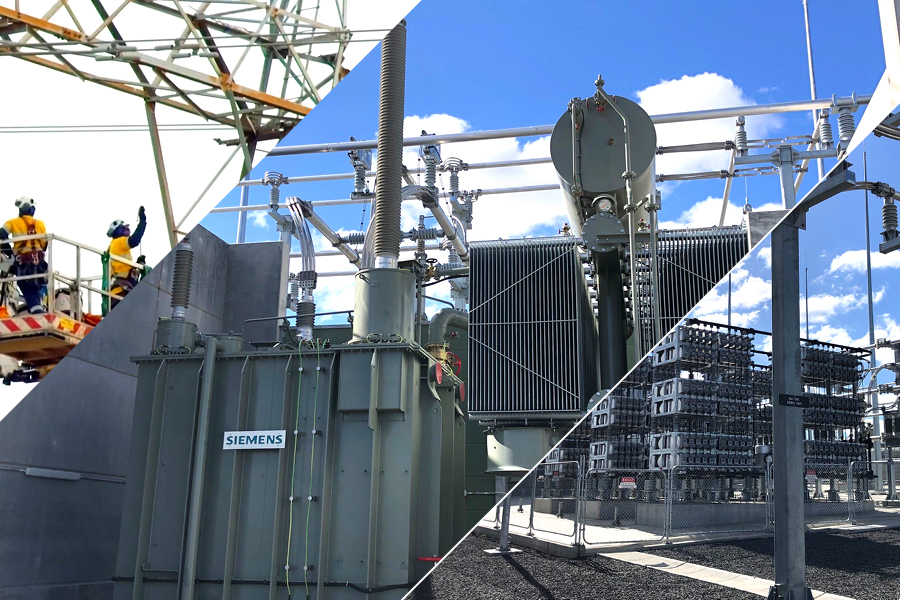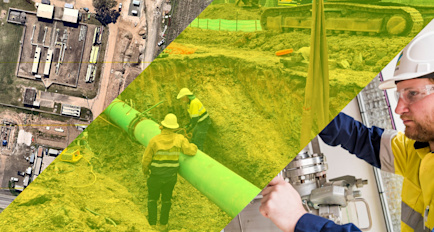The QNI transmission upgrade supports around 460MW of energy heading north to Queensland, and 190MW coming south into New South Wales. This critical development of national infrastructure is estimated to deliver $170 million in net benefits to Australia's electricity consumers, while simultaneously supporting the country's energy transition.
The project's timely and budgetary success comes from ensuring the appropriate, trusted and experienced teams delivered the work – for all 82,000 hours of manpower.
Setting up for shared success
Zinfra was initially engaged to assist Transgrid with the QNI upgrade in 2019. From the tender stage, Transgrid allocated Zinfra a series of upgrades to the line and substations along the project.
Zinfra Operations Manager Paul Robinson said the Transgrid and Zinfra alliance highlighted the power of collaborative partnerships on the critical work which will significantly boost transmission and support development of new renewable energy zones over the coming years.
Zinfra also brought their design partner, Beca on board, where they worked hand-in-hand during the design process.
"We had a very close design process, ongoing meetings with all three parties involved going through the 20 per cent concept design, the 45, the 85 and the IFC design processes, making sure everyone was consulted along the way," Mr Robinson said.
True partnerships benefit all parties, and utilise all partners' experience.
Experienced capability
There were three substations that required significant work, and Zinfra was allocated the Armidale location, as well as significant infrastructure upgrades to the line components of the project. These upgrades tested Zinfra's planning and scheduling ability to ensure all components were delivered on time.
"The Armidale substation involved the construction, testing and commissioning of four new 330kV capacitor banks and replacement of the existing 330kV shunt reactor," Mr Robinson said.
"In the lines component, we upgraded the lines, which made it possible to run power through it at 120 degrees Celsius, as opposed to the existing 85 degrees Celsius. We did that by increasing the conductor height, and that was done using several methods.
"It was either pole replacement, insulator replacements, or insulator string rearrangements and landscaping and additional tower strengthening works associated with those augmentations."
Innovative pole replacement was a key part of the methodology, which would allow Zinfra to keep its work on budget and on time for the QNI upgrade.
This is where Zinfra's design partnership with Beca came to the fore.
Zinfra worked with Beca to design the transmission pole, that met the structural and constructability needs of the project. Specifically, the poles needed to facilitate a construction methodology to minimise the length of outages during the works.
"The project had a fairly tight timeframe, so we, in collaboration with Beca and Transgrid, chose to apply a higher strength reduction factor in our design which then eliminated the need for pole testing, which would add three months to the program," Mr Robinson said.
"The second aspect was introducing a bolted flange connection type design, so that it allowed the construction of the pole arrangement in such a way that we could partially erect the poles without outages," Mr Robinson said.
The joint decision on the pole design allowed the completion of the rest of the work with only one day's outage, meaning Zinfra could return to the line to service it each night, as opposed to a standard design that would have required a multi-day outage.
The final, innovative step implemented by Zinfra was to remove and dismantle the structures the project was replacing. Again, Zinfra understood the importance of the project's schedule, and planned a controlled demolition (or felling) of the towers which expedited the process.
The success of the project's pole implementation with Beca led to the submission of its work for a collaborative design award at the Consult Australia Awards, where it made the 2022 award finals.
In total, Zinfra replaced 58 structures, strengthened 35 structures and augmented about 250 insulator arrangements.
A people-powered project
According to Mr Robinson, it's the people behind the project, and their commitment to safety, that were critical to its success.
"Across 82,000 man hours, we had over 200 per cent of our lead HSE audit actions undertaken versus planned and about 135 per cent of our leading behavioural actions are undertaken versus planned," Mr Robinson said.
As Zinfra worked on its components throughout the early lockdown and border restrictions of the COVID-19 pandemic, the (sometimes daily) changes to lockdown rules created another challenge to keep workers safe. But Mr Robinson explained that looking after the blue collar workforce was a paramount focus for Zinfra.
"Ultimately, they're the guys who get the job done," Mr Robinson said.
"We had interstate workers that couldn't get home because of border closures. Some of them did months and months on end of work on this project without getting home. So we were quite focused on their wellbeing, looking after them, making sure and doing what was necessary to the extent that we could to keep them as satisfied and as sane as possible during that difficult period."
Zinfra, whose project delivery team is competent, capable and led by trusted managers, collaborated with their selected industry partners to foster the ultimate productive environment. This curated environment with its partners was pivotal to the success, on-time delivery and completion of Zinfra's components on the QNI project.
Transgrid CEO Brett Redman thanked Zinfra for helping it build the transmission super-highway which will transform the energy supply for millions of Australians.
"There will be no transition without transmission", Mr Redman said.




